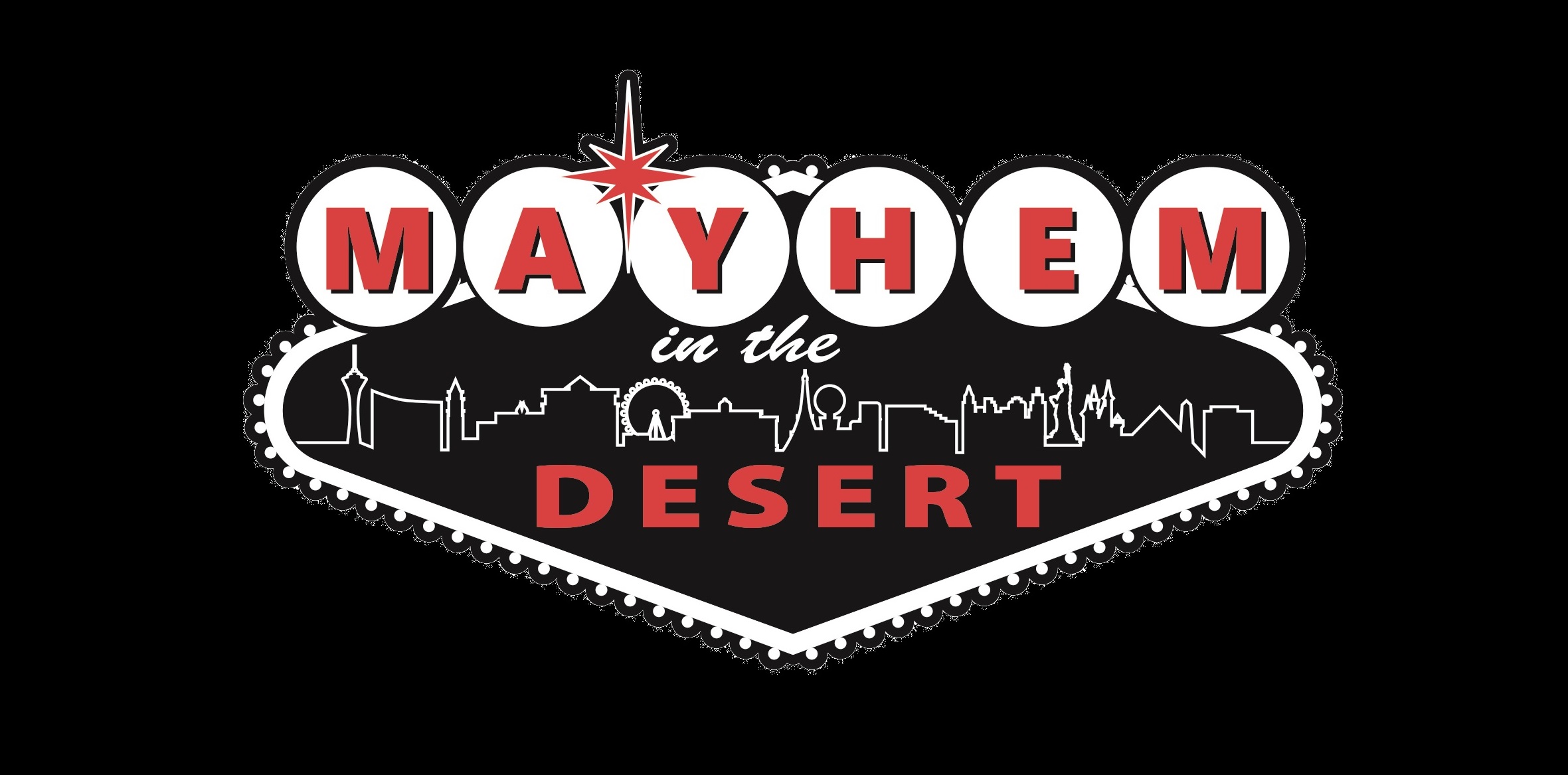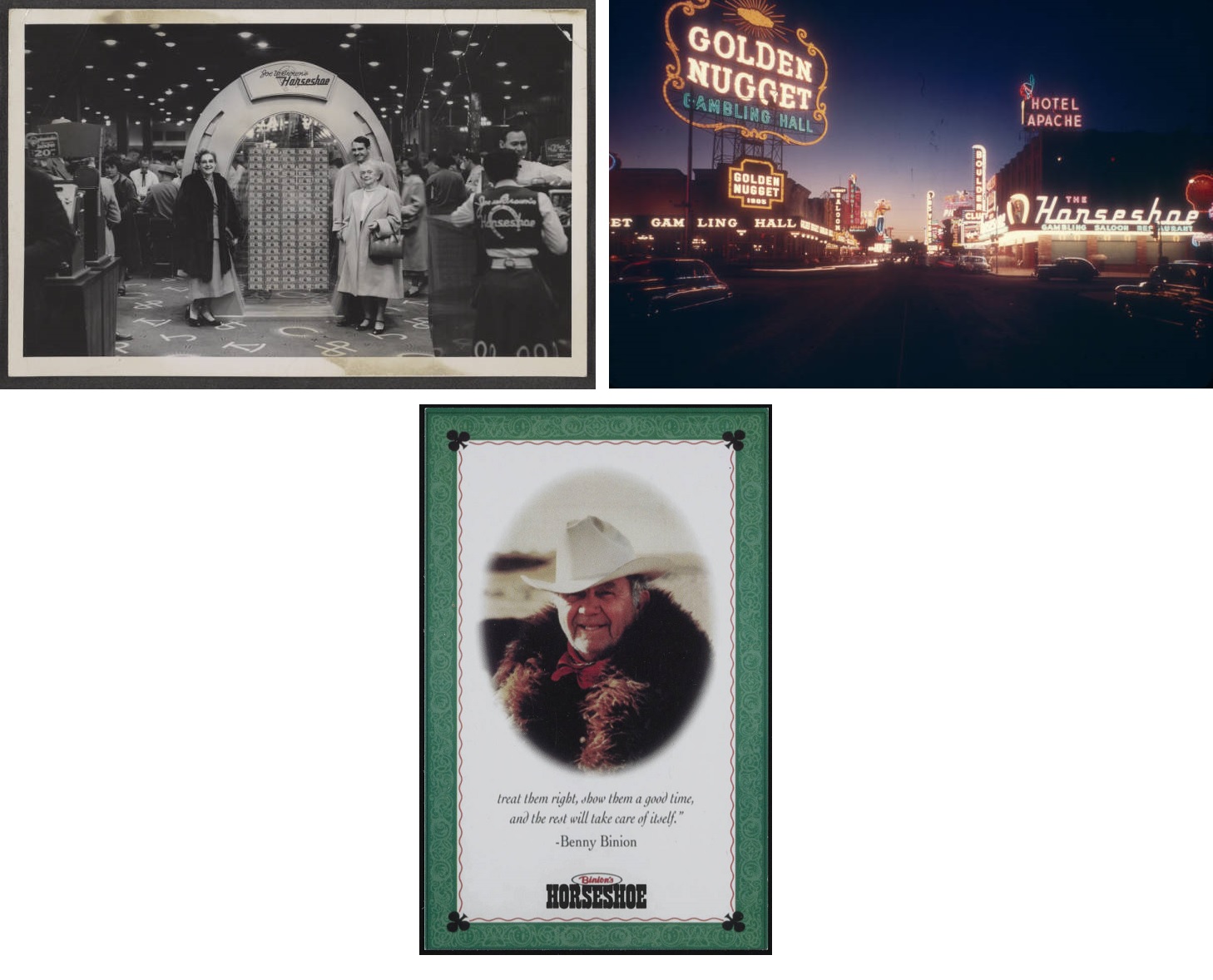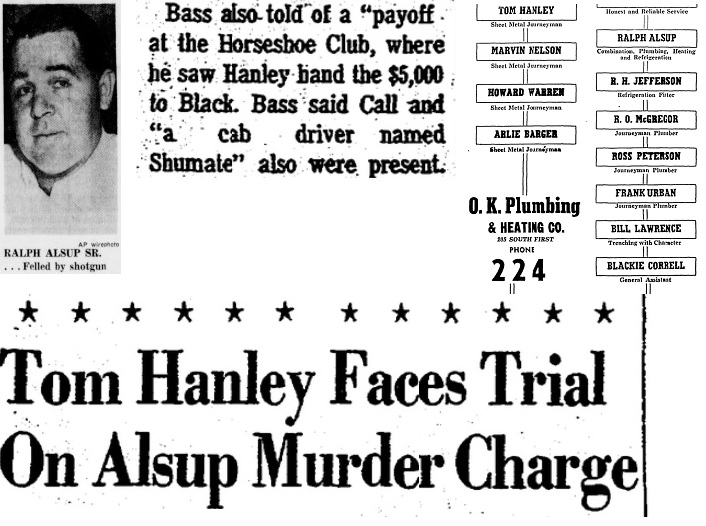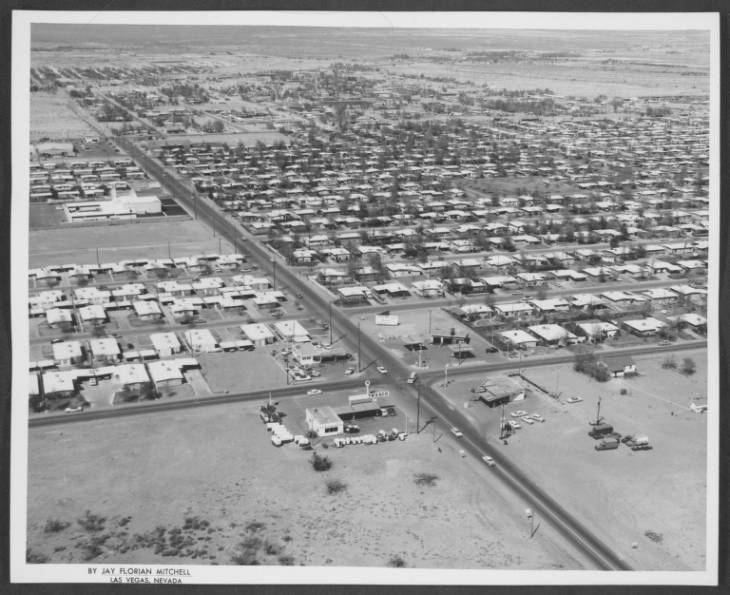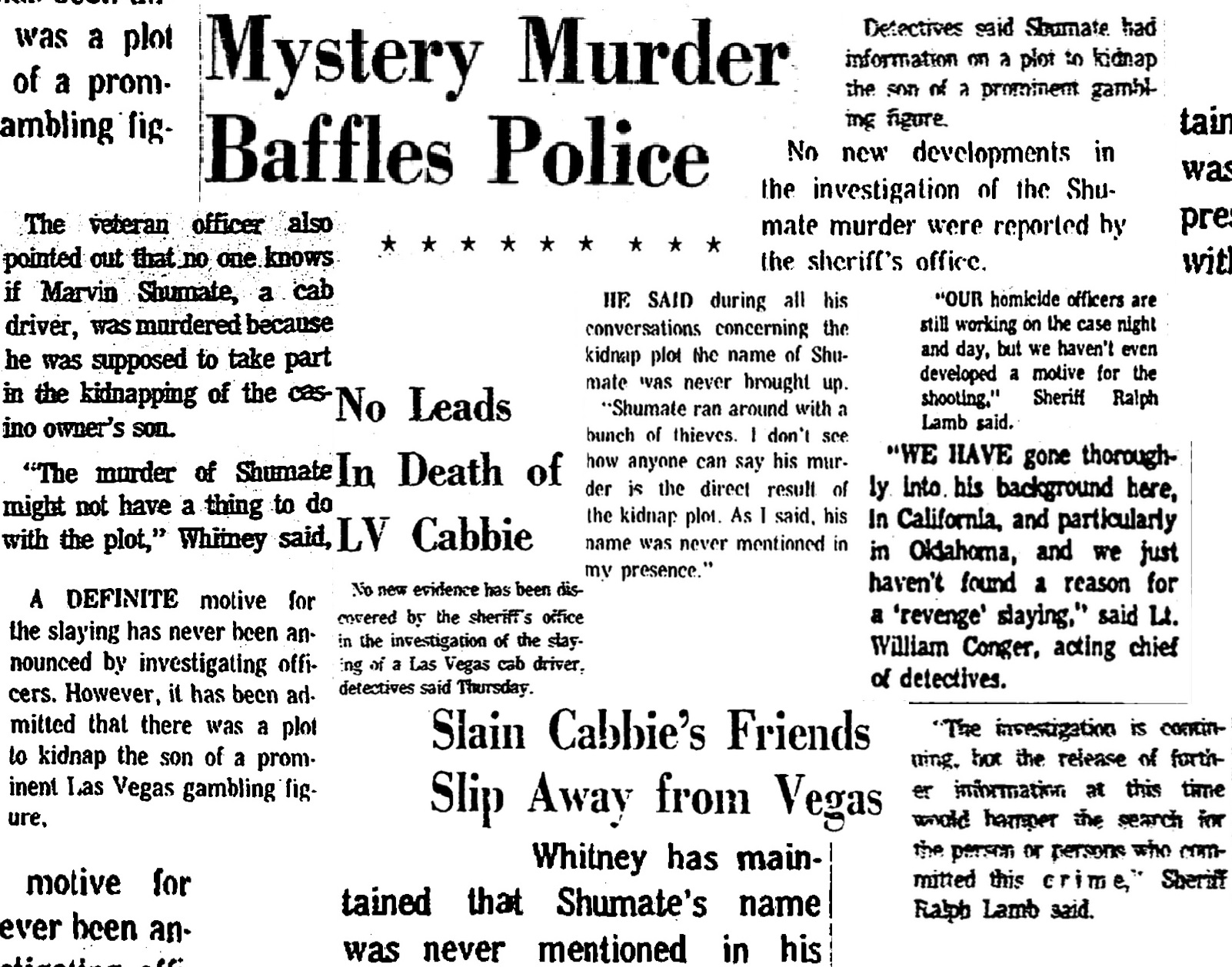kidnapping a gangster’s son
“Do your enemies before they can do you.”
Photo of Ted Binion (Left) with his father Benny circa 1973, a few years after the foiled kidnapping plot. (UNLV Digital Collection)
benny binion: the kindest gangster in Vegas
The trial surrounding the murder of casino heir Ted Binion was one of the most sensational cases in Las Vegas history, garnering national attention. But decades before tales of jilted lovers, underground vaults in the desert brimming with silver bullion, and of a man rapidly squandering his wealth on a wild lifestyle, Ted Binion was at the center of another Vegas murder tale.
Benny Binion, the founder and owner of Binion’s Horseshoe Casino in downtown Las Vegas from 1946 until his death in 1989, was known for being an affable Texan with a reputation for taking care of his family as well as his employees. In fact, these authors’ father/father-in-law worked as a pit boss at Binion’s Horseshoe while it was under the management of Benny Binion, and he had nothing but kind words to say about the old gambler-turned-legitimate businessman and philanthropist.
But despite his friendly demeanor, “Old Man Binion” never shed his roots as a notorious Dallas organized crime figure of the 1930’s and 40’s that oversaw a sprawling network of illegal gambling dens throughout that city. During his Dallas days, Binion maintained his extensive gambling network by faithfully following the rule, “Do your enemies before they can do you.” That ethos resulted in numerous deaths during Binion’s time at the top of the Dallas organized crime heap.
Aftermath of the car bombing allegedly ordered by Benny Binion that murdered the wife of his chief rival in the gambling rackets. The bombing occurred in front of the Dallas home of Binion’s rival. (Texas Monthly)
the toughest gambler in dallas
Binion openly admitted to the killing of two men in Dallas. In 1931, Frank Bolding, a local rumrunner, entered Binion’s backyard where he encountered the gambler sitting on a crate. Bolding charged Binion with a knife in hand. The quick-reacting Binion tipped his crate over and fell backwards, only to peer back over the crate with gun-in-hand, firing several shots to bring down his attacker. This deadly scuffle resulted in Benny Binion being given the nickname “the Cowboy.”
Then in 1936, Binion was facing encroachment on his territory by rival racketeer Ben Frieden. In response, one day in September of that year, Binion approached on foot as his competitor sat unaware in a parked car in a neighborhood under Binion’s control. Frieden was cut down by a round from Binion’s .45 automatic before he knew what was happening. Binion pulled a second pistol from his person and gave himself a flesh wound before throwing the firearm inside Friedan’s vehicle. When the police arrived, Binion explained that it had been a simple matter of self-defense on his part. The local district attorney bought Binion’s explanation and he walked without facing any charges.
But then there were the other murders Binion never talked about. After all, discretion and the ability to keep a secret were essential to long-term success in his sort of enterprise. A chief enforcer for Binion in Dallas was Lois Green, a hitman whose signature was burying his victims alive, a practice that gave potential competitors pause before deciding to enter the gambling racket. And among the more brazen crimes in which the cunning gangster allegedly played a hand was the daylight car bombing that killed the wife of Binion’s chief rival in front of their Dallas home.
In the end, it wasn’t Binion’s rivals that drove him out of Dallas, but instead the election of reform-oriented “good government” officials, including a new district attorney elected in 1946 on an anti-corruption pledge. The final straw was when Binion’s chosen candidate for sheriff was defeated in that same election. Ever the expert gambler, the Cowboy knew when to fold. He left Dallas for Las Vegas in 1946 with two suitcases loaded with cash to continue his profession, but with one difference – he would be in the one place in America where on paper he’d be a respectable businessman.
(Clockwise from top left) The iconic display of a million dollars in cash on the floor of Binion’s Horseshoe Casino in downtown Las Vegas; Exterior view of the Horseshoe Casino circa 1950’s; Promotional material featuring Benny Binion’s motto for running a successful casino: “Treat them right, show them a good time, and the rest will take care of itself.” (UNLV Digital Collection)
the horseshoe
Benny founded the Horseshoe Casino on Fremont Street in downtown Las Vegas in 1946. The Horseshoe gained notoriety for its friendliness to gamblers – there were no limits on wagers – as well as its down-home atmosphere. Patrons were welcome to wear jeans and button-down shirts rather than the suits and ties expected at the establishments popping up a few miles away along what would become known as “The Strip.”
Though Benny Binion was able to gain legitimacy in a place like Las Vegas – and while he preferred to resolve things above-board if possible – old habits die hard. And if push came to shove, Benny never hesitated when he believed it necessary to return to the tools of the trade that served him so well back in Dallas – hit men, car bombs, bribery of local officials – and all utilized with a ruthless entrepreneurial efficiency.
And a sure way to trigger the bad side of Benny Binion was to come after what he cherished most – his wife and five children, particularly his favorite child, Ted.
Aerial view of Oklahoma City at the time Marvin Shumate resided there and made his living as a pool hall operator and manager of illicit gambling rackets from 1954-61. Note the oil derricks not far from downtown OKC. ("Historic Photos of Oklahoma City" / Turner Publishing)
marvin shumate: a former crook trying to go straight
Like most residents of Las Vegas since its founding, Marvin Weldon Shumate was not a native of the city. After being born in a town a few miles north of Dallas at the time when Benny Binion was consolidating control of that city’s rackets, Shumate spent most of his life in Oklahoma. For over a decade he ran a pool hall in Oklahoma City, facing by his own admission hundreds of arrests, though he claimed he had never served a day in jail for any of the charges brought against him, usually for liquor and betting violations.
But Marvin eventually left the heat in Oklahoma City and headed west to Las Vegas in 1965, and by 1967 the 43-year-old had settled down with his wife and three children in a working class neighborhood making a living as a cab driver with the Whittlesea Blue Cab Company. Marvin told those close to him that he planned to stay on the straight-and-narrow after leaving Oklahoma behind. But he also couldn’t help naturally striking up friendships with other men carrying a criminal past, both at work and at Pappy’s Bar - a watering hole for locals that Marvin frequented every day after work in a cramped shopping center at the intersection of Flamingo Road and Paradise Boulevard, less than a mile from the glow of the Strip.
There really was a part of him that wanted to go legit, but in the end Marvin continued to remain easily enticed by under-the-table or otherwise illicit opportunities to bring in a few extra bucks here or there. It’s tough to find a new profession at forty-three. And the daily grind of shuttling drunk tourists around town only reinforced his long-held belief that honest work just doesn’t pay.
Marvin Shumate should have known that Benny Binion’s chief enforcer, hitman and union boss Tom Hanley, had no problem killing former friends and associates. (Clockwise from top left) Ralph Alsup was head of the powerful local plumbers union until he was ambushed and killed at his Vegas home; former Hanley associate Alphone Bass testified Shumate was present when Hanley orchestrated the assassination of Alsup; ad from the local Vegas paper noting Alsup and Hanley worked for the same plumbing and heating company; headline after Hanley’s arrest for the murder of his former business associate. (UNLV Digital Collection / Las Vegas-Clark County Library District)
getting rich quick the riskiest way possible
By 1967, Marvin Shumate had fallen into the orbit of the most famous gambler in town and some of that gambler’s toughest enforcers. This included Tom Hanley, head of a local gaming employee union and Binion’s go-to hitman. Marvin, the former small-time gambler, had gotten so deep that he was even present in late-1965 at the downtown Horseshoe Casino when Hanley and his cohorts were planning the assassination of the head of a local plumbers’ union.
Things could have continued to go well for Marvin if he wanted. He could have kept his day job and brought in cash on the side by doing small jobs for Binion and Hanley. In fact, Marvin’s time at the Horseshoe Casino led to his 22-year-old son Dennis striking up a friendship with 24-year-old Ted Binion. Marvin Shumate’s young son and Ted Binion spent their time partying hard and fully embracing the vices offered by the growing city of Las Vegas. While Ted was nominally an owner with his brother of the Horseshoe due to Benny’s ineligibility to hold a gambling license as a result of his criminal history, his father was still the de facto day-to-day operator of the downtown casino. And young Ted Binion was content to indulge in women, drugs, and booze while his father took care of business.
But Marvin overreached. Sometime in late-1967 an idea occurred to him – a scheme that would leave him a wealthy man. He would use information inadvertently provided by his son to learn Ted Binion’s routines. Then, Marvin and some of his friends from the cab company and Pappy’s Bar would kidnap the casino heir in order to collect a hefty ransom from Old Man Binion.
The neighborhood near Eastern and Owens where Marvin Shumate settled with his family in an effort to put the gambling rackets of Oklahoma City behind him, circa 1965. Shumate was willing to risk kidnapping and murdering the favorite son of ruthless gambling boss Benny Binion in order to move beyond this working-class neighborhood. (UNLV Digital Collection)
from a kidnapping plot to a murder plot
One of the four men Marvin enlisted into the kidnapping plot was a friend at the bar – a dealer at a local casino with an extensive criminal history by the name of Bill Wade. When Marvin told Wade the broad contours of the plan to kidnap the young Binion, the dealer was entranced by the prospect of earning a quick payday that would allow him to leave behind his day job.
Marvin and his co-conspirators refined the details to the kidnapping plot over the course of a few weeks in late-1967. But as they worked out the details, Marvin came to a cold realization that a crucial change of plans was necessary. The only way to get away with the ransom money would be to kill Ted Binion after the ransom was received.
“There’s no other way,” Marvin explained in separate conversations to his cohorts. Marvin sensed some resistance to the thought of murder from Wade. He explained to his friend that if they allowed Ted to live, the young Binion would in short order be able to provide the Old Man with enough information to link Marvin to the plot via his son’s relationship with Ted. There was no record of violence in Marvin’s past back in Oklahoma, but the former small-time gambling ring operator was now upping the ante to murder.
Wade told his friend that he understood what had to be done.
While Wade understood, he did not agree with the change in plans. He was no murderer. A thief and extortionist, yes – but not a murderer. Wade fretted over what to do, and a chill would run through him when he finally came to the conclusion as to the only course of action left to him. He had to let Old Man Binion know about the plot.
Detective Mike Whitney (right) had a spotty service record but enjoyed the publicity afforded to him in his role as a police officer (the detective is pictured here in the local newspaper accompanied by several Strip showgirls). Whitney moonlighted working for Benny Binion, including acting as an intermediary to tip Old Man Binion off about the kidnapping plot. (Las Vegas Clark County Library District)
a compromised cop tips off the Old Man
Bill Wade reached out to a man he called “the only honest cop in town” – Detective Mike Whitney. He had information about a planned kidnapping, but Wade needed a promise from Whitney – no one else at the police department would be involved in disrupting the plot. While Whitney’s role and motives in this tale are subject to speculation, it seems likely there is a significant divergence between what a long-time peripheral underworld figure and what the rest of society would consider an “honest cop.”
Wade told Detective Whitney to relay life-or-death information to one of the most powerful and ruthless casino magnates in Las Vegas. The casino dealer needed Benny Binion to know he had become aware of chatter regarding a plot to kidnap his son. And Wade also wanted Benny to know that he had the name of the man behind the plot – some cabbie named Marvin Shumate.
After taking steps to notify Old Man Binion of the kidnapping-turned-murder plot, Wade cut off contact with Marvin and tried to continue leading a normal life. He attempted to reassure himself that Benny would have no reason to suspect that he had any involvement in the plot. If Marvin tried to say anything like that, why, that would just be the lies of a desperate man trying to save his life. Right?
Wade was relieved when a few days later Detective Whitney met him to let Wade know that Old Man Binion appreciated the tip and that action would soon be taken to stop the kidnapping plot before it could proceed any further. In fact, the old gambler was so grateful that he wanted the detective to deliver $500 to Wade (about $3,750 today).
Corruption was rampant among law enforcement officers in mob-controlled 1960’s Las Vegas, with the rot stemming from the top on down. Sheriff Ralph Lamb would later face federal scrutiny for accepting large “loans” that were never expected to be repaid from Benny Binion. And Detective Whitney appears to have been on Old Man Binion’s payroll as well since he failed to inform any of his superiors about the tip from Wade regarding an apparent kidnapping plot targeting Ted Binion. While Whitney later protested that he did everything he could to foil the kidnapping, it is more likely that upon informing Old Man Binion of the plot against his son, the detective received a tidy sum for “reward money” and then let the ruthless gambler handle the situation as he saw fit.
Tom Hanley, the elder member of a father-son hitman team, who is the prime suspect in the murder of kidnap plotter Marvin Shumate.
Marvin Shumate’s forced Trip to the Desert
Marvin Shumate didn’t see his old pal Wade at their watering hole on Flamingo Road any more. He was starting to have second thoughts himself about the whole scheme. The notion crept into his head that Wade may have turned informant. Marvin began to wonder if it was even worth it at this point.
The evening of December 2, 1967, was a Saturday, which meant that Marvin had a busy shift chauffeuring tourists. But he still managed to get off near his normal quitting time of 8:00 p.m. After he dropped his taxi off at the depot, the creature of habit headed to the same spot he headed every night after work - Pappy’s Bar.
Marvin exited his vehicle, planning to contemplate his next move over several rounds of drinks. But he never made it inside the bar. A man exited a vehicle as Marvin headed toward the bar and intercepted the cab driver. It was a familiar face – Tom Hanley.
Marvin smiled and greeted his acquaintance. “Hey, we need a little help with some business tonight. Big payoff for you and shouldn’t take long. Let’s go,” Hanley said, gesturing to his waiting car.
What could Marvin say other than, “Sure, Tom. You know I’m game.” Delusion is a powerful thing, and Marvin Shumate clung to a belief that it was merely coincidence that Wade had stopped going to the bar after the topic of murdering Ted Binion had been broached and that now, a few days later, one of the Old Man’s most ruthless triggermen was inviting him for a late-night ride.
Marvin noted two men in the backseat as he approached Tom Hanley’s vehicle. One of Hanley’s associates - likely Hanley’s longtime friend Alphonse Bass - stepped out of the backseat, allowing Marvin to take a seat in the middle. The car took off down Flamingo Road and headed toward the endless desert surrounding the city.
Sunrise Mountain, located on the east side of Las Vegas, as it appeared around the time Marvin Shumate was taken by associates of Benny Binion for a late night drive to the mountain on December 2, 1967. (UNLV Digital Collection)
a gangland execution
At a certain point during the drive – once the car made its way past the last houses lining Lake Mead Boulevard, past Nellis Road, and into the pitch black – Marvin could no longer deny what was about to happen. His mind raced. Maybe he could talk his way out of this situation like he had so many other tough binds back in Oklahoma. “Guys, we can work this out,” he started.
“Stop,” Tom Hanley said from over his shoulder while navigating his vehicle through the darkness down the desolate two-lane road. They continued the rest of the drive in silence until the vehicle pulled to a stop in the dirt along the side the road. Hanley killed the ignition.
Hanley and his associates exited the vehicle along with Marvin into the frigid winter air. A few hundred yards in the distance stood Sunrise Mountain – a promontory guarding the east end of the Las Vegas Valley. The middle-aged former pool hall operator stood shivering, the silhouettes of Hanley and his triggermen standing against the luminescent glow of the city in the distance. “Let’s go for a walk,” Hanley said. Marvin could hear one of his captors opening the trunk of the car to retrieve something.
Marvin complied. There was no way out, and he knew it. The hitmen followed Marvin for a few feet toward one of the trails winding along Sunrise Mountain. About thirty feet off from the road one of the trio told Marvin, “Turn around.”
Marvin turned and confronted Tom Hanley wielding a shotgun. The cab driver raised a hand in defense. A thunderous boom rang throughout the empty desert as Hanley fired a single round into Marvin’s chest from a distance of three feet, sending him crumpling to the freezing desert floor. Marvin lie motionless on the ground, the blast having destroyed his heart and lungs. But Old Man Binion’s enforcers were out here on a mission that had to be completed, which is why one of them approached Marvin’s body and fired a single round from a .38 revolver into his head just behind the ear.
Then they got in their car and drove back to the city.
Headlines from the local paper after Shumate’s corpse was discovered near Sunrise Mountain in late 1967. (Las Vegas-Clark County Library District)
Local fireman Monte Sprague and his wife were taking a late-night drive down Lake Mead Road about an hour after Marvin’s murder when the headlights of their car illuminated a horrific site. Sprague hopped out of his vehicle to confirm that he had just happened to stumble across a bloodied corpse. He returned to town and immediately contacted police.
The murder made front pages of the local papers and police officers fanned out into the desert along Lake Mead Road in search of clues that might lead to the identity of the murderers, which included using metal detectors to locate shell casings. It was clear that robbery had not been a motive since Marvin was found with money in his wallet and his car keys still on his person.
While the press made glancing references to the murder being associated with a kidnapping plot involving the son of a “prominent downtown gambling figure,” the police refused to disclose the identity of this mysterious “gambling figure” – though it quickly became an open secret around town that Benny Binion had employed some of the tactics he learned back in Dallas to defend his family.
Bill Wade, casino table dealer and part-time crook, was given 24 hours to skip town after tipping Benny Binion off about the kidnapping plot targeting his son. (Las Vegas-Clark County Library District)
“You’ve got 24 hours to get out of town…or else.”
Bill Wade was aware that his old drinking buddy had been executed on the orders of Old Man Binion because he was involved in the cover-up of the plot. After the murder, Hanley contacted Wade and told him to bury the murder weapons in the desert. Wade met Hanley and complied with his request.
Wade hoped that would be the end of the whole messy and ill-conceived kidnapping plot. But a few days after Marvin Shumate’s brutal murder, Wade received an anonymous call while drinking at Pappy’s Bar. He picked up the receiver and was told by a voice he didn’t recognize, “You’ve got twenty-four hours to get out of Vegas. Or else.” Click.
He froze in panic. Wade left the bar and headed immediately to Las Vegas Police Department headquarters where he told officers he feared for his life and that he had information that might help them solve the Shumate murder.
Sheriff Ralph Lamb, the close friend of Benny Binion, agreed to lock up Wade in a spare cell to protect him from those that had threatened to do the casino dealer harm. However, during the course of Wade’s three-day stay in protective custody he was met in his cell by Detective Whitney, the intermediary that had relayed Wade’s tip about the kidnapping plot to Benny Binion. Whitney told Wade that he had learned of the threat his informant had received at the bar. He was here to reiterate that there was really no good reason for Wade to remain in Vegas and also to give Wade an additional $300 from Old Man Binion to cover his relocation costs.
Wade heeded the detective’s advice and asked to be released from protective custody. He promptly fled the heat in Las Vegas for less life-threatening environs. In fact, Wade went about as far as he possibly could, ultimately ending up on the East Coast.
Photo of Mike Whitney (who never shied away from publicity) from the local paper after the detective helped locate an illegal sub-machinegun, contrasted with a later headline announcing his suspension for questionable behavior in the Shumate case. (Las Vegas-Clark County Library District)
detective whitney takes heat
Detective Whitney, who had evaded scrutiny for his moonlighting on behalf of Benny Binion, was suspended a few weeks after the slaying of Marvin Shumate when it became known he had been acting as an intermediary between Binion and Wade without telling his superiors. Whitney, a thirteen year veteran of the police force, vehemently maintained that he was only trying to bust a kidnapping plot, nothing more and nothing less. His superiors towed the same line – Sheriff Lamb told reporters there was no evidence Marvin Shumate had even been involved in the kidnapping plot targeting Ted Binion.
After a few weeks, Detective Whitney was cleared of wrong-doing and stayed on with the police force. Marvin Shumate’s other associates involved with the kidnapping plot fled Las Vegas by January of 1968. And the official line from the police was that there were no leads in the murder of Marvin Shumate, but perhaps the killing was revenge related to Marvin’s dealings back in Oklahoma City. Sheriff Lamb told reporters that there would be “no arrests considered in the immediate future.”
Alphonse Bass (right) - one of the men that likely accompanied Shumate on his drive out into the desert the night of December 2, 1967 - later went on to turn State’s witness against his former employer, ruthless mob hitman Tom Hanley. Bass was murdered in a Las Vegas arson in 1969, and though Hanley was charged with murdering his former associate he was acquitted of the crime. Bass is pictured here as part of local press coverage of Tom Hanley’s murder trial for the slaying of a local union boss. (Las Vegas-Clark County Library District)
not the last body in the desert
The Shumate murder would surface again later in 1968 and result in more murder in the Las Vegas Valley. Tom Hanley was arrested that year for the 1966 murder of plumbing union boss Ralph Alsup, who had been cut down by a shotgun wielded by a hidden gunman lying in wait just after the union boss arrived at his Vegas home and stepped out of his vehicle.
A key witness for the State of Nevada was one of Hanley’s most reliable henchmen, Alphonse Bass, who testified not only to Hanley’s role in Alsup’s murder, but also in the murder of Marvin Shumate. Hanley’s attorneys put on a stellar defense that resulted in Hanley’s acquittal of the Alsup murder charge.
Prosecutors had no time to gain more information from Bass about the Shumate killing. On March 30, 1969 Alphonse Bass arrived at the house of Tom Hanley’s sister in central Las Vegas after she called to complain of a home emergency in need of a handyman. Bass prided himself in helping friends fix things around their homes and he arrived as soon as he was able.
Bass took only a few steps into the home before he was grabbed by an assailant and injected with a powerful sleep agent. Once the attacker was certain Bass was unconscious, he acted quickly to douse Hanley’s sister’s home in accelerant (she shouldn’t care too much – after all, she’d get a decent payout from the insurance company). Though Hanley was incarcerated at the time of the Bass murder, he faced charges for ordering the hit. Like in the Alsup case, Hanley was acquitted of murdering his former flunky.
There were never any arrests or charges in relation to the Shumate murder. These headlines note the official police line that there were no clear links between Shumate and the kidnapping plot. However, the lack of clear links was due to a central witness, Detective Mike Whitney, being on the payroll of Benny Binion. It also didn’t hurt that the chief law enforcement officer in Las Vegas - Sheriff Ralph Lamb - was a close friend of Old Man Binion and had received tens of thousands of dollars in “loans” from the powerful gambler that were never repaid. (Las Vegas-Clark County Library District)
the limits of the law in mob-era vegas
The murder of Marvin Shumate officially remains unresolved. It helped that, outside of the Shumate family, there was no public outcry demanding justice for the slaying of an unreformed small-time crook. And even if there had been, there was no way to make a case against Shumate’s killers. One of the key witnesses to the events leading up to the murder, Detective Whitney, was on Benny Binion’s payroll and maintained the line that Shumate’s name never came up during his discussions with Old Man Binion about the kidnapping plot.
And Sheriff Ralph Lamb, the chief law enforcement officer in Las Vegas, was not about to devote police resources under his control to solving the Shumate slaying. After all, he knew that any investigation would land at the doorstep of his close personal friend and benefactor Benny Binion.
Sheriff Lamb could not have gone after Binion even if he had been so inclined. Just like back in Dallas, the old-time gangster had co-opted the top cop in town by providing him tens of thousands of dollars in “loans” that were never repaid. Any investigation of Binion by Sheriff Lamb would end up being an investigation into the sheriff’s own wrongdoing. In addition to abiding by the rule that he needed to “do his enemies before they did him,” Binion also knew that when everyone is dirty, no one is guilty.
(Clockwise from left) Ted Binion in his later years before his 1998 death; Sandy Murphy and Rick Tabish with legal team during their trial for murder of Ted Binion; Millions of dollars of silver located in Ted Binion’s rural desert vault.
silver, heroin, and strippers: ted binion’s tragic end
Ted Binion survived the attempt on his life hatched by Marvin Shumate, but he never outgrew his taste for partying. By the late 1990’s, Ted had fallen into a serious heroin addiction and playboy lifestyle that ended in him becoming the victim of a murder plot, possibly in an effort to steal millions of dollars in silver bullion the casino fortune heir kept buried on his property in the desert fifty miles north of Las Vegas.
